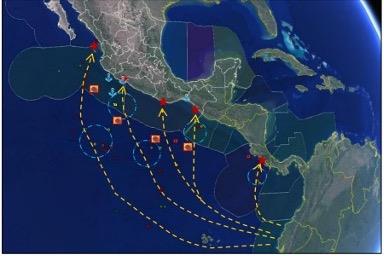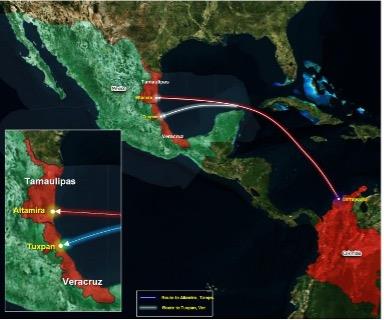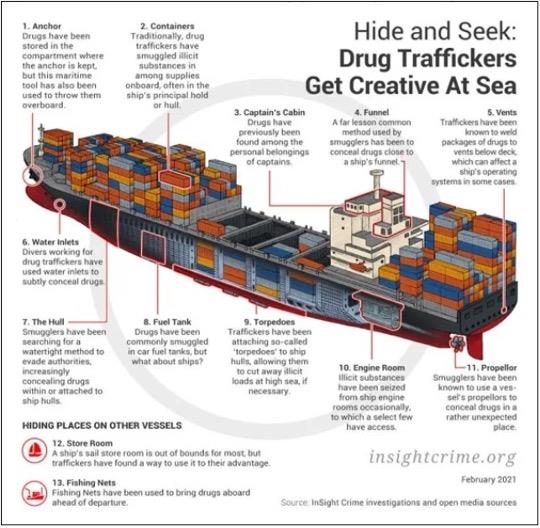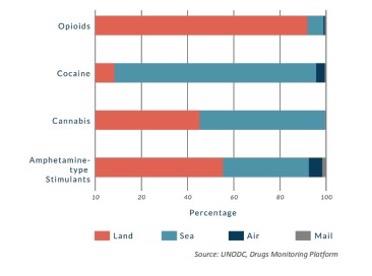
Combating Illicit Maritime Drug Flows to the United States May 02, 2024
Cartels traffic over $100 billion worth of illicit narcotics to the United States per year. U.S. law enforcement struggles to combat illicit maritime drug flows due to consistent improvements in drug trafficking operations and the large number of individual shipments. Cartels use maritime routes in the Eastern Pacific and Caribbean Sea because it has less risk and high reward, and it is easy to bypass security measures. Some top policy recommendations to counter illicit drug flows include strengthen partnerships, diversifying security measures, increase enforcement jurisdictions, increase funding for technology at seaports, and implementing a domestic welfare program.
Law enforcement agencies in the United States struggle with combatting illicit maritime drug flows into and through the country. Maritime drug trafficking involves “the cultivation, manufacturing, transnational smuggling, and distribution of drugs and sale of substances.” Latin American countries, such as Peru, Ecuador, Colombia, and Mexico, are the largest sources of illegal narcotics to the United States. Transnational criminal organizations (TCOs) in these countries use independent resources to facilitate transportation.
The cartels transport it through their land, air, and sea assets to diversify their risk. The TCOs then ship the drugs by sea to Mexico and Guatemala. Most of the drugs are transported through the U.S. border by the cartels’ land assets. Lastly, cartels within the U.S. distribute the drugs to local consumers on the black market. The main idea of the article is to address the ways and means of how TCOs in Latin America traffic narcotics, and how to combat illicit maritime drug flows to the United States.
Drug Sources and Production:
While entities all over the world smuggle drugs into the United States; most producers are in Peru, Bolivia, Colombia, and Mexico. The cartels mainly produce opioids, cocaine, and marijuana and use TCOs to connect and operate the supply chains and distribution networks. Due to corruption in the host countries, TCOs can transport illicit narcotics to key departure points with relative ease, such as seaports or coastlines. Most key departure regions for drugs destined for the United States are coastlines in Colombia and Ecuador. Then, through this international system, the cartels send narcotics through various land, air, and sea assets, predominately through secondary and tertiary transshipment points to limit and diversify risk.
Illicit Maritime Narcotic Operations in Transit:
International drug trafficking includes a point of origin, transshipment points and countries, and a destination. Maritime transport significantly facilitates narcotics operations by providing organized crime networks with convenient and discreet means to traffic substantial amounts of drugs. Specifically in the maritime domain, narcotraffickers use a variety of means to transport illicit drugs. Some ways include commercial cargo ships, private vessels (yachts and speedboats), and self-propelled semisubmersible vessels (narcosubs). As shown through the two maps below, TCOs primarily use these maritime routes and ports to traffic narcotics in the Pacific Ocean and Caribbean Sea. TCOs use the Pacific Ocean routes more because there is more open water without law enforcement or counter-narcotic security measures.


Cargo Ships: TCOs use commercial cargo ships to traffic drugs in which they conceal narcotics anywhere within a cargo ship, such as cargo containers, the engine room, vents, and the fuel tank. Furthermore, traffickers even attach drug-filled containers to the hull underwater or drag the drug-filled containers behind the ship. The most common method of illicit containerized trade, however, is to hide it within the containers; this method is known as “container hijacking.” Seaport law enforcement personnel have a hard time inspecting the inside of every container within the port because of the sheer volume of containers.

Private vessels: TCOs transport small quantities of narcotics on speed boats because these boats are more challenging to detect, interdict, and capture. Speed boats mainly transport drugs from transshipment countries in the Caribbean to Florida. Additionally, if port authorities and local law enforcement are effective, drug traffickers covertly load these speedboats and transport the narcotics over to cargo ships. Then, the cargo ships transport the drugs over long distances to the destination before local speedboats at the new port take the drugs from the ship to land with ease and efficiency.
TCOs also smuggle narcotics with private yachts. The climate makes leisure activity attractable year-round, and the massive U.S. coastline on the Atlantic and the Gulf of Mexico makes it difficult to find, track, and capture these vessels. Law enforcement cannot search every vessel, so this alternative is appealing.
Narcosubs: Drug traffickers use narcosubs because this method has low risk and high reward. This vessel can covertly transport narcotics while semi-submerged because it has a small wake, low heat signature, and limited emissions- some narcosubs are even electric, which makes it even harder to find. The most common route for these subs is the eastern Pacific. About 80% of illicit narcotics travel through the Pacific and around 14% through the Caribbean. The TCOs assessed that sending more subs with smaller cargo is better than having fewer subs with larger cargoes to reduce the impact of individual seizures. These vessels usually have two to four crewmembers on board and can carry multi-ton cargo. The vessel is cheap and generally discarded after each use. Another challenge with detecting narcosubs is that each sub differs from the next, so using the same means to detect each sub will likely fail. Independent personnel build, source, and transport narcosubs; the transit crew is often separate. So, finding the networks is more complicated. Additionally, locating the subs before departing from the coast is challenging because they launch from the dense jungles and mangroves. The supply chain is massive and complex to track.
The primary endpoint for these maritime vessels is in Guatemala, El Salvador, and Mexico. Once the vessels unload their cargo, the TCOs use their land assets to transport the narcotics to the United States via the border because it is easy to execute and has a high success rate.
Modes of Drug Transportation in Seizures, by Substance, from Jan 2017 to April 2020

There are two main destinations for illegal drugs sourced from Latin America: the United States and Europe. On the one hand, after the narcotics arrive in Mexico, most of them are shipped through the land border of the United States rather than the coastlines. While on the other hand, narcotics travel directly to United States coastlines and seaports. The easiest way to seize drugs is at the border because it all gets consolidated in chokepoints. Once the drugs are in the United States, the TCOs distribute the drugs to their networks across the country. Then the drug dealers sell the narcotics to local consumers.
Policy Options:
Policy discussions around issues such as border security, drug trafficking, and the opioid epidemic often involve questions about illicit drug flows into the United States. There are two perspectives involved with counter-narcotics policies. The first is combatting the supply, and the second is combatting demand. If there is a high demand, there will be a supply. The United States has a high demand for drugs, and the cartels have a high supply. The first four policy options below address the supply issue, while the fifth addresses the demand issue.
Strengthen Partnerships: No agency or department within the United States government can complete this mission alone. So, interagency collaboration and international agreements on counter-narcotics are necessary. The producing regions in Latin America are outside of U.S. jurisdiction. Hence, international cooperation with our law enforcement agencies is needed to stop the flow from the source. The U.S. military, Coast Guard, law enforcement, and intelligence agencies can complete the objective by reinforcing bilateral and multilateral agreements. The Joint Interagency Task Force South (JIATF-S) within the United States is an excellent example of an interagency task force to detect and monitor suspected drug traffickers. JIATF-S has a lot of success with leading Campaign Martillo, which is a counternarcotic operation in the Central American region. JIATF-S seizures hundreds of millions of dollar’s worth of illicit narcotics a year and continues to be a great example of interagency cooperation.
Diversifying Border Security Measures: The border is the single most significant entry point for TCOs to smuggle narcotics into the United States. TCOs use various ports of entry to smuggle drugs, weapons, and people. Currently, the United States does not enforce have adequate border security policies. Enforcing the border through personnel, barriers, innovative technology, and surveillance equipment would help solve the issue. This policy decision is necessary to limit the supply of narcotics transiting into the country and for national security.
Increase Funding and Boost Technology at Seaports: Increasing funding to national, state, and local law enforcement would help seize more illicit cargo, but it would also slow down shipping operations, which means prices would increase and disrupt supply chains. So, boosting technology would efficiently impact counter-narcotics operations at seaports. Innovative technology such as artificial intelligence, automation, digitalization, security alarms, and X-ray surveillance technology to see within containers are likely options.
Increase Enforcement Jurisdictions: The Maritime Drug Law Enforcement Act (MDLEA) was a set of laws enacted in the 1980s to curb drug trafficking through maritime vessels. This set of laws allows the U.S. government to prosecute maritime transit crimes outside its territory. With almost all maritime illicit narcotics operations occurring outside of U.S. waters, this law is essential to combating drug flows. The Customs and Border Patrol, Drug Enforcement Agency, and Coastguard Laws are law enforcement entities that can enforce the MDLEA through at-sea interdictions. Additionally, imposing more substantial penalties would also disincentivize criminals to drug trafficking. This initiative will limit the supply of narcotics coming into the country. Within U.S. borders, law enforcement must only abide by U.S. laws, rules, and regulations rather than international law and the laws of other sovereign nations.
Domestic Welfare Program: Lastly, the real problem in combating the drug trade is the high demand for narcotics within the United States. If there is no demand, TCOs would not have an incentive to supply narcotics. The only way to decrease the demand is through domestic welfare programs. People could use health welfare programs to overcome drug addiction. Most drug addicts cannot afford rehab, so a state or federal program is an option for them. The issue with this policy decision is that it is costly and politically controversial. However, it is a real solution to a real problem.
__________________________________
Orion Policy Institute (OPI) is an independent, non-profit, tax-exempt think tank focusing on a broad range of issues at the local, national, and global levels. OPI does not take institutional policy positions. Accordingly, all views, positions, and conclusions represented herein should be understood to be solely those of the author(s) and do not necessarily reflect the views of OPI.
